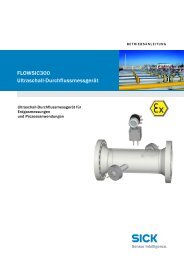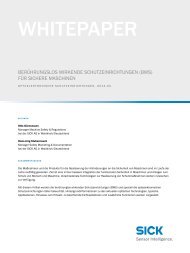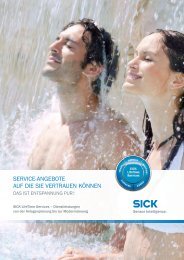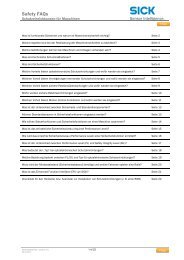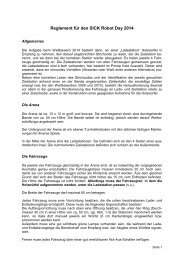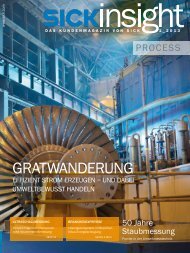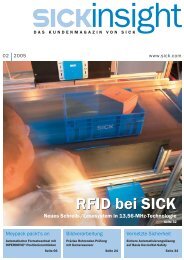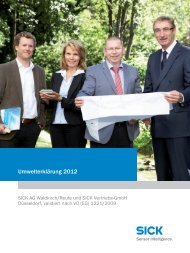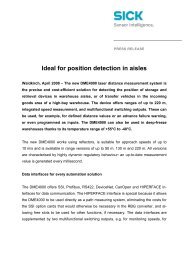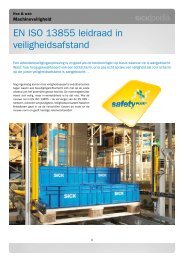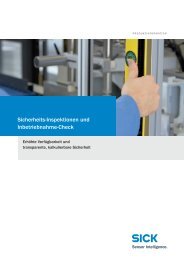Barcodescanner CLV62x ... CLV64x mit Schutzgehäuse IP ... - Sick
Barcodescanner CLV62x ... CLV64x mit Schutzgehäuse IP ... - Sick
Barcodescanner CLV62x ... CLV64x mit Schutzgehäuse IP ... - Sick
Create successful ePaper yourself
Turn your PDF publications into a flip-book with our unique Google optimized e-Paper software.
8. Wartung und Pflege<br />
Der <strong>Barcodescanner</strong> <strong>mit</strong> <strong>Schutzgehäuse</strong> arbeitet wartungsfrei,<br />
abgesehen von der Reinigung des Lesefensters bei Verschmutzung<br />
oder Benetzung <strong>mit</strong> Feuchtigkeit (z.B. Wasser).<br />
‣ Um die volle optische Leseleistung zu erhalten, das Lesefenster<br />
des <strong>Schutzgehäuse</strong>s in regelmäßigen Zeitabständen (z.B.<br />
wöchenlich) auf Verschmutzung kontrollieren. Besonders in<br />
rauer Betriebsumgebung (Staub, Abrieb, Feuchtigkeit etc.).<br />
‣ Zur Lesung muss das Lesefenster grundsätzlich trocken und<br />
sauber sein.<br />
Lesefenster reinigen:<br />
HINWEIS<br />
Beschädigungsgefahr des Lesefensters!<br />
Verminderte Leseleistung durch Kratzer oder Schlieren auf dem<br />
Lesefenster!<br />
Das Lesefenster des <strong>Schutzgehäuse</strong>s besteht aus Kunststoff.<br />
‣ Keine aggressiven Reinigungs<strong>mit</strong>tel wie z.B. Aceton verwenden.<br />
‣ Kratzende und scheuernde Bewegungen auf dem Lesefenster<br />
vermeiden.<br />
‣ Gerät für die Reinigungszeitdauer ausschalten (Laserschutz!)<br />
oder falls nicht möglich, eine Laserschutzbrille tragen, die die<br />
verwendeten Wellenlängen (siehe Kapitel 12. Technische Daten,<br />
Seite 18) absobiert und eine Schädigung der Augen wirksam<br />
verhindert.<br />
‣ Lesefenster nur feucht reinigen!<br />
Hierzu ein sauberes, weiches und fusselfreies Tuch verwenden,<br />
das <strong>mit</strong> einem milden, antistatischen Reinigungs<strong>mit</strong>tel befeuchtet<br />
ist.<br />
WICHTIG!<br />
Ist das Lesefenster des <strong>Schutzgehäuse</strong>s zerkratzt oder beschädigt<br />
(Sprung, Bruch), muss das Fenster durch SICK ersetzt werden.<br />
Hierzu Kontakt <strong>mit</strong> dem SICK Service aufnehmen.<br />
Empfehlung<br />
Durch statische Aufladung können Staubteilchen am Lesefenster<br />
hängen bleiben. Dieser Effekt kann durch Anwendung des antistatischen<br />
SICK Kunststoffreinigers (Nr. 5600006) in Kombination <strong>mit</strong><br />
dem SICK Optiktuch (Nr. 4003353) vermindert werden.<br />
9. Transport und Lagerung<br />
Den <strong>Barcodescanner</strong> <strong>mit</strong> <strong>Schutzgehäuse</strong> in der Originalverpackung,<br />
<strong>mit</strong> angeschraubten Schutzstopfen/-kappe für die elektrischen<br />
Anschlüsse, transportieren und lagern. Das Gerät nicht in luftdichten<br />
Behältern lagern, da<strong>mit</strong> eventuell vorhandene Restfeuchtigkeit<br />
entweichen kann. Keinen aggressiven Medien (z.B. Lösungs<strong>mit</strong>tel<br />
wie Azeton) aussetzen.<br />
Lagerbedingungen:<br />
Trocken, staubfrei, keine direkte Sonneneinstrahlung, möglichst<br />
erschütterungsfrei, Lagertemperatur –20 ... 70 °C, relative Luftfeuchte<br />
max. 90 % (nicht kondensierend).<br />
10. Reparatur<br />
Reparaturen am <strong>Barcodescanner</strong> <strong>mit</strong> <strong>Schutzgehäuse</strong> dürfen nur<br />
von ausgebildetem und autorisiertem Service-Personal der SICK AG<br />
durchgeführt werden.<br />
11. Demontage und Entsorgung<br />
Ein am Ende des Produktlebenszyklus’ unbrauchbar gewordener<br />
<strong>Barcodescanner</strong> <strong>mit</strong> <strong>Schutzgehäuse</strong> ist umweltgerecht gemäß der<br />
8. Maintenance and Care<br />
The bar code scanner with protective housing operates without the<br />
need for maintenance, except for cleaning the reading window if it<br />
gets contaminated or wet (e.g. by water).<br />
‣ In order to obtain maximum reading performance, the reading<br />
window of the protective housing must be checked for contamination<br />
at regular intervals (e.g., weekly). This applies especially<br />
in harsh environments (dust, abrasion, moisture, etc.).<br />
‣ For reading, the reading window has to be generally dry and<br />
clean.<br />
Cleaning the reading window:<br />
NOTE<br />
Risk of damage to the reading window!<br />
Reduces reading performance due to scratches or smears on the<br />
reading window!<br />
The reading window of the protective housing is made of plactic.<br />
‣ Do not use aggressive cleaning agents like e.g. acetone.<br />
‣ Avoid cleaning motions on the reading window which could<br />
cause scratches or abrasion.<br />
‣ Switch off the device for the duration of the cleaning (laser<br />
protection!) or if this is not possible, wear laser protection<br />
goggles, which absorb the wavelength used (see Chapter 12.<br />
Technical Data, page 18) and effectively prevent damage to the<br />
eyes.<br />
‣ Plastic reading windows must only be wet-cleaned!<br />
Use a clean, damp and lint-free cloth and a mild, anti-static<br />
window cleaning fluid.<br />
IMPORTANT!<br />
If the reading window of the protective housing is scratched or<br />
damaged (cracked, broken), the window must be replaced by SICK<br />
service personnel. Please contact the SICK Service.<br />
Recommendation<br />
Electrostatic charges can cause dust particles to adhere to the<br />
reading window. This effect can be combated by using anti-static<br />
SICK Synthetic Cleaner (No. 5600006) in combination with a SICK<br />
Lens Cloth (No. 4003353).<br />
9. Transport and Storage<br />
The bar code scanner with protective housing (and tightened<br />
protective socket/plug for electrical connections as in delivery<br />
condition), must be transported and stored in its original packaging.<br />
The device must not be stored in airtight containers, so that any<br />
residual moisture is able to escape. Do not expose to aggressive<br />
media (e.g. solvents such as acetone).<br />
Storage conditions:<br />
Dry, dust-free, no direct sunlight, vibration-free to the extent<br />
possible, storage temperature –20 ... 70 °C, relative air humidity<br />
max. 90% (non-condensing).<br />
10. Repair<br />
The repair work on the bar code scanner with protective housing<br />
may only be performed by qualified and authorized service personnel<br />
from SICK AG.<br />
11. Disassembly and Disposal<br />
At the end of the life time cycle, any bar code scanner with protective<br />
housing which can no longer be used must be disposed of in an<br />
16 # 24 © SICK AG · Germany · All rights reserved · Subject to change without notice · Irrtümer und Änderungen vorbehalten<br />
8015720/2013-04



